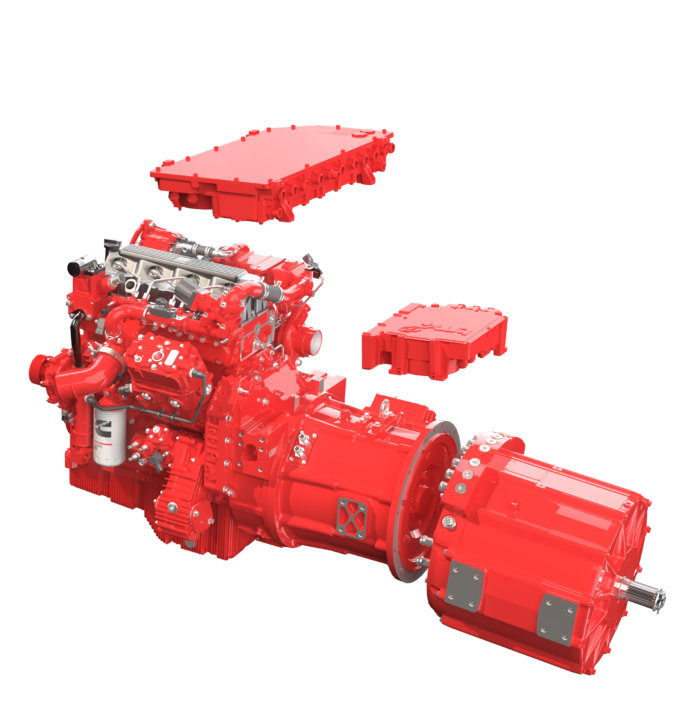Cummins Inc. has kicked off this week’s American Public Transportation Association (APTA) Expo in Atlanta by revealing electrified power technology for transit bus applications, as well as announcing a new partnership with bus manufacturer Gillig.
At APTA, Cummins is displaying a new powertrain, configurable for either a full battery electric vehicle (BEV) or a range extended electric vehicle (REEV) incorporating a compact engine-generator. Cummins says its electrified power systems are ideally suited for integration into transit, shuttle and commuter buses, enabling direct drive-by-wire continuous acceleration. With the bus operating in battery-only mode, the system achieves zero emissions at the point of use.
Enhanced energy storage for both the BEV and REEV systems is achieved using Cummins’ high-density battery enclosure, which are compact and modular and allow for both on-roof and chassis integration, the company adds. The design also fits into existing bus designs.
“The introduction of our new BEV and REEV systems will complement Cummins’ clean-diesel, near-zero natural gas and diesel-hybrid products to offer the broadest, most energy-diverse power portfolio in the bus industry. We are able to meet the needs of every transit route, every duty cycle and every emissions standard in the most cost-effective manner,” says Julie Furber, executive director of Cummins Inc.’s electrification business.
The standard-size Cummins battery enclosure provides a 70 kWh storage capability with up to eight enclosure units (560 kWh) suited for installation within the BEV bus. The company says this enables a zero-emissions range of up to 224 miles on a single charge, with an energy consumption of 25 miles per gallon diesel, which provides significant cost reductions.
Cummins says its REEV system has a battery pack of three enclosures (210 kWh), which can provide a zero-emissions range of up to 84 miles. When the battery pack depletes to a low state-of-charge, the REEV system brings online a 150 kW (201 hp) engine-generator to recharge the batteries and continue operations with ultra-low emissions capability.
Compared to the standard diesel-powered bus, the REEV 4.5-liter engine is downsized by about 50% in terms of displacement and can achieve up to 10 miles per gallon, significantly lowering the carbon footprint. A power assist function is available from the battery pack whenever the system needs additional energy, Cummins notes.
The company says the REEV system’s ability to switch between shorter-range battery-only mode and extended-range generator mode allows transit authorities to geofence specific downtown areas by utilizing Cummins over-the-air connected technology. The REEV system also enables buses to travel significant distances beyond the city charging infrastructure.
“A key focus in the design of both our BEV and REEV systems ensures the electrified architecture is modular and adaptable to enable an easier technology transition for bus manufacturers,” says Brian Wilson, general manager of Cummins’ global bus business. “This allows transit authorities to continue using the same preferred bus models and retain fleet commonality.”
Wilson adds, “The new systems will be expertly serviced and supported by Cummins’ distribution network the same way we currently provide 24/7 support for our diesel-, hybrid- and natural-gas-powered fleets. This is an important factor for transit authorities, because as they adopt new technologies, they can count on Cummins to help with a transition to BEV and REEV technology.”
At APTA, Cummins also announced an electrified power partnership with Gillig LLC, a manufacturer of heavy-duty transit buses in the U.S. According to a press release, the technical development agreement focuses on integrating and optimizing new battery electric technology from Cummins that will soon power Gillig zero-emissions transit buses.
“Gillig has a very strong business relationship with Cummins – and now, with our new technical partnership, we have been able to share our respective technology roadmaps and jointly develop a vision to deliver the most comprehensive, advanced technology battery electric bus in the market for our customers,” says Derek Maunus, president of Gillig, in the release.
Amy Boerger, Cummins’ vice president of North America sales, comments, “The Cummins electrified powertrain on show here at APTA represents a major leap forward for the industry, and we are delighted that Gillig will have first access to this important zero-emissions technology. The partnership enables a close technical collaboration so we can accelerate system integration and performance optimization work to leap ahead of others in the industry.”
According to the partners, initial development work for the new battery electric Gillig bus envisions a 200-mile operating range on a single charge. The bus will feature a direct-drive traction motor with peak torque of 3500 Nm (2582 lbs-ft) and utilize energy recovered from a regenerative braking system. A package of e-accessories will be powered by the Cummins system. The initial bus deployment will use a plug-in charger.
“Beyond the technical development work, the partnership will also encompass the full range of 24/7 service support, diagnostics, over-the-air connectivity, flexible warranty plans and training programs ready for when these Gillig electric buses enter service,” says Boerger.
Cummins currently powers the Gillig series of Low Floor, BRT, BRTPlus, Commuter and Trolley buses with a broad portfolio of clean-diesel, near-zero natural gas and diesel-hybrid power. The addition of Cummins electrified power systems aims to the bus range will align with transit customers looking to introduce zero-emissions buses to their fleets while still maintaining commonality with their existing Gillig vehicles and service support provision.
“Cummins and Gillig have been working together since the 1950s to introduce innovative bus power solutions, and I am really excited to be continuing that success forward into the new era of electric buses,” concludes Maunus.
Image courtesy of Cummins: Cummins’ range extended electric vehicle (REEV) system with 4.5-liter engine-generator and traction motor.





